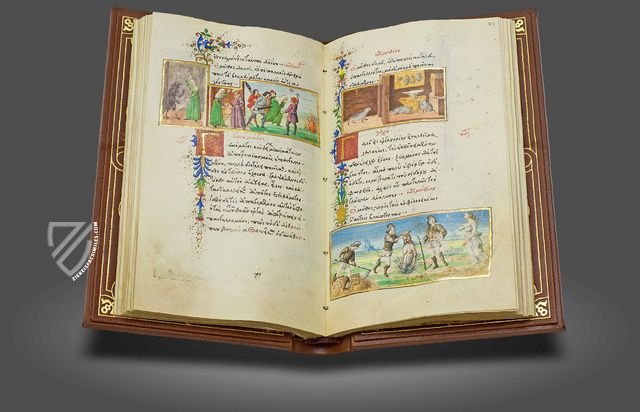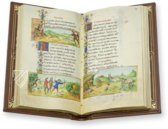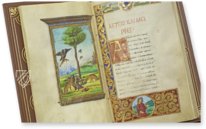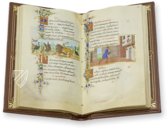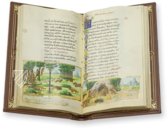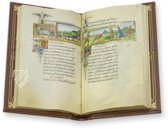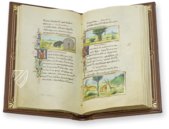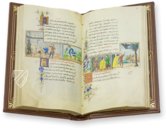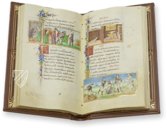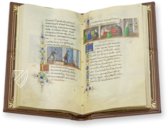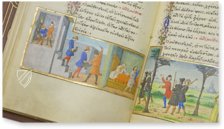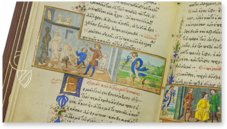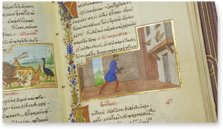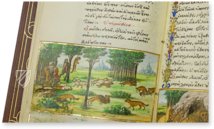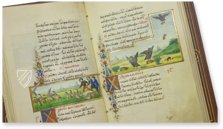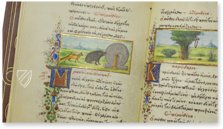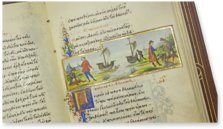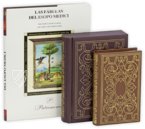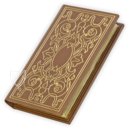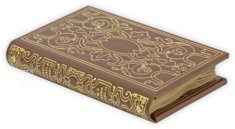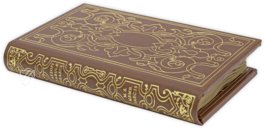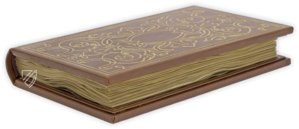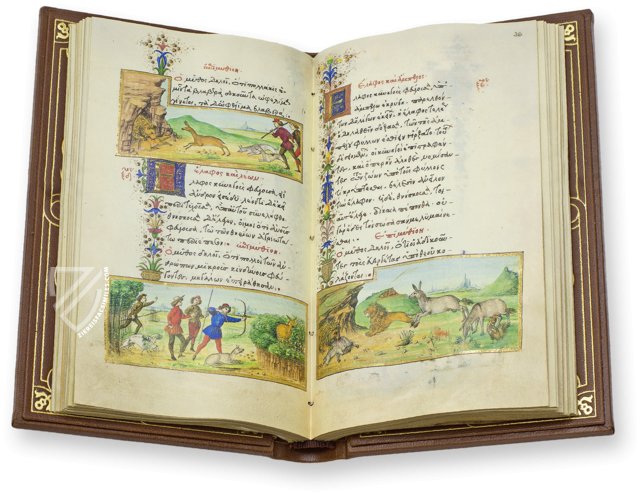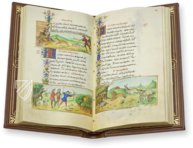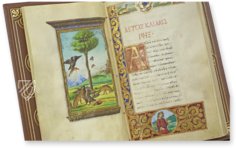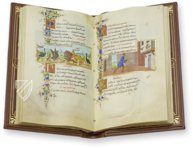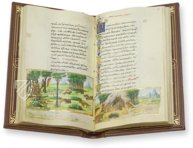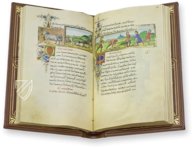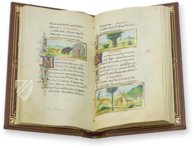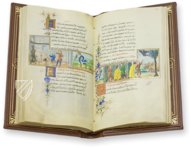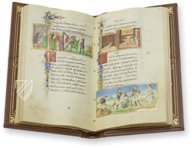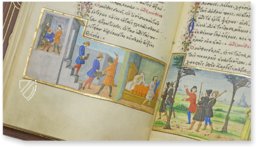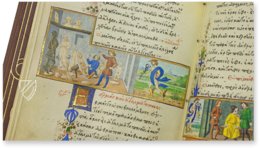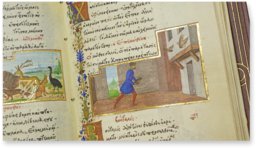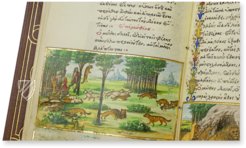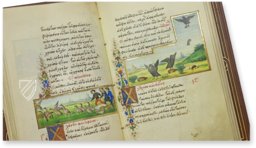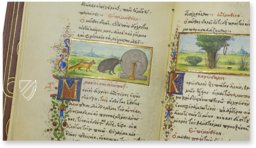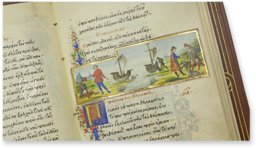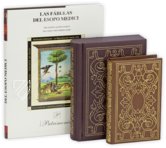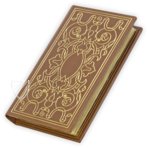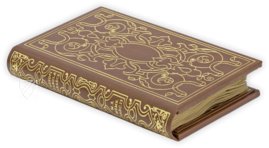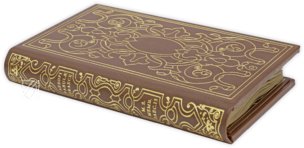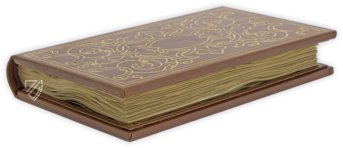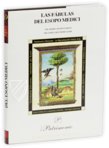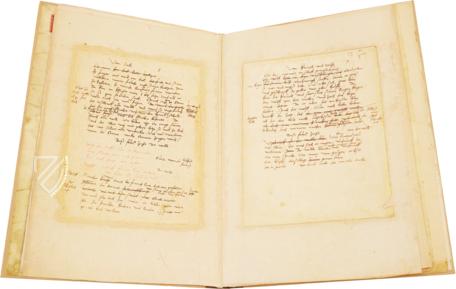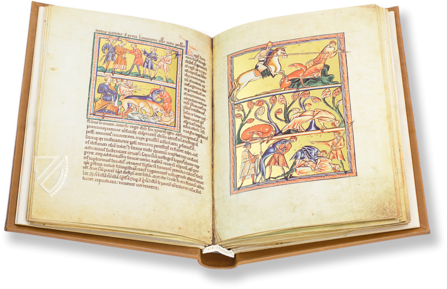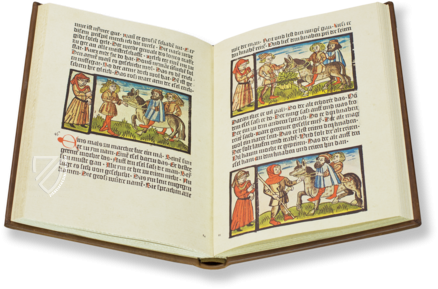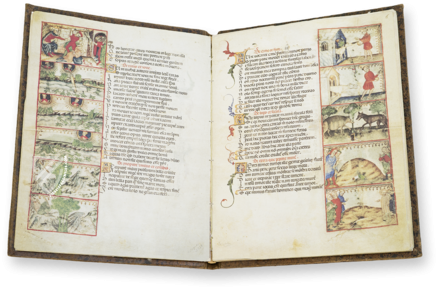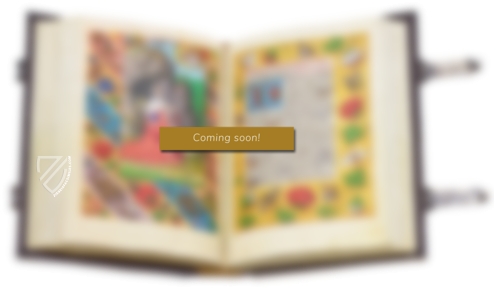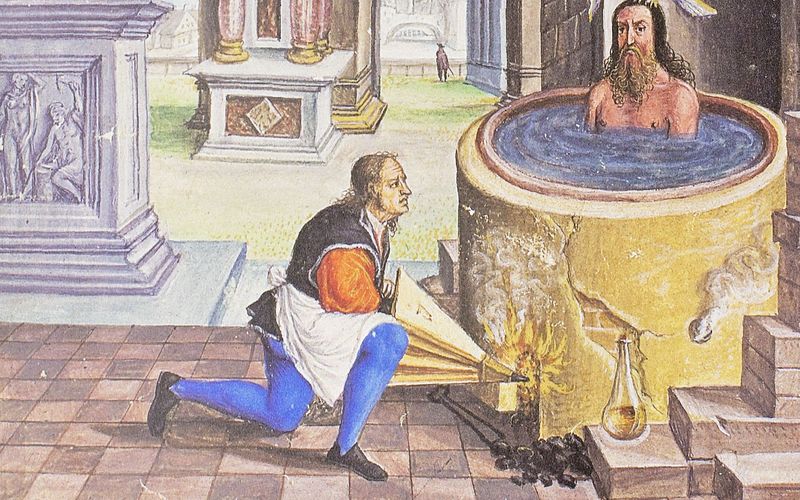Medici Aesop
(3,000€ - 7,000€)
This wonderful collection of fables from the the Greek writer Aesop is illustrated with the most beautiful illustrations in this manuscript. Originally intended as a Greek textbook for Piero de Medici in Florence ca. 1480, this manuscript offers a deep look into the tremendous art of the Italian Renaissance. The famous fables from antiquity with animal and human protagonists impress with their playful lessons in moralistic life as much today as they did in the 16th century. This edition of the Medici manuscript is even today the most beautifully illustrated and furnished collection of Aesop’s Fables.
Medici Aesop
This wonderful collection of fables from the the Greek writer Aesop is illustrated with the most beautiful illustrations in this manuscript. Originally intended as a Greek textbook for Piero de Medici in Florence ca. 1480, this manuscript offers a deep look into the tremendous art of the Italian Renaissance. The famous fables from antiquity with animal and human protagonists impress with their playful lessons in moralistic life as much today as they did in the 16th century. This edition of the Medici manuscript is even today the most beautifully illustrated and furnished collection of Aesop’s Fables.
A Schoolbook for the Offspring of de Medici
Lorenzo I de Medici, known as il Magnifico, the Magnificent, undoubtedly commissioned the Aesop-Edition for his son Piero. For the time around 1500, this wasn’t anything special, but the return of the classic Greek texts in the Renaissance lead to a new discovery of the Greek writer, Aesop (620–560 BC). It was not only the moralistic aspect of the fables that was important, but the original language of the texts, Greek, was also in high demand as a relic of the past. Aesop’s Fables were already widely available in a Latin translation in Late Antiquity and in the Middle Ages, but were later re-translated into the original Greek ca. 1300. Thus, Aesop received new meaning as an entertaining and educational lecturer, his work instructed many young men in Greek. One can well imagine that Piero de Medici also used this manuscript with that goal in mind. The manuscript’s connection to the influential Florentine Medici family is demonstrated not only by inventory lists that prove Piero de Medici’s ownership of the book, but also due to a direct piece of evidence that lies in one of the miniatures; a small Medici Coat of Arms is recognizable.
Illustrations of Animals from the greatest Artists
Throughout the 150 pages, a variety of Aesop’s Fables are presented and illustrated with 135 half-page miniatures, which are enriched with gold. An unknown writer copied the text in around 1480 in Milan from a printed edition of Bonus Accursius. Mariano del Buono (1433–1504) and the Master of the Hamilton Xenophon can be identified as the artists adoring the book, who were both masters of manuscript art in the 16th century. They designed the pages with gorgeous initials and floral ornaments alongside a left-side border around the text. The wonderful and impressive miniatures are like panel paintings in narrow borders conveniently integrated in text. A bright world of animals populate the miniatures: donkeys, horses, dogs, rabbits, all manner of birds, wild boar, foxes and camels. Altogether, the wondrous spiritedness and realism of the Renaissance is depicted. Grandiose, airy landscapes highlight the representations. The artistic and lovingly designed miniatures, by the same token, embrace the adjoining text’s juxtaposition with animals, people, and God, as the individual stories go hand-and-hand with one another. The coloring and the wonderfully crafted depictions of animals are not only entertaining for adults, but also certainly for children. They underline the anecdotes that Piero de Medici certainly learned as a kid from this present manuscript, with represents one of the most beautiful illustrated editions of Aesop’s Fables from the Renaissance.
Codicology
- Alternative Titles
- Esopo Medici
Medici-Aesop
Les Fables d'Ésope
Le Fiabe dell’Esopo Mediceo - Size / Format
- 150 pages / 20.0 × 12.0 cm
- Origin
- Italy
- Date
- Ca. 1480
- Epochs
- Style
- Genre
- Language
- Illustrations
- 135 half-page miniatures adorned with gold
- Patron
- Lorenzo I. de’ Medici (1449–1492)
- Artist / School
- Demetrios Damilas (d. after 1506) (scribe)
Francesco di Antonio del Chierico (1433–84), Mariano del Buono (1433/34–1504), and others (illuminators) - Previous Owners
- Lorenzo’s son, Piero (1471–1503)
Medici Aesop
Author Portrait
In a bas-de-page miniature like this that appears at the beginning of a manuscript, one would normally find a dedication miniature or some other portrait of the patron. However, this in no way resembles the patron of this manuscript, Lorenzo de’ Medici, whose likeness is well known, nor does it resemble his son Piero, for whom the manuscript was made. Thus, framed in a brilliant field of red and gold, we must conclude that this is the artist’s conception of Aesop himself.

Medici Aesop
The Eagle and the Fox
One of Aesop’s Fables is intended to serve as a warning that the powerful should fear revenge from the humble people that they harm, or alternatively, of the danger of betrayal. In the story, an eagle and a fox are friends and decide to live together, seen here by the proximity of the eagle’s tree to the fox’s den. However, the eagle betrays the fox by stealing one of its cubs to feed to its young.
The fox prays for vengeance, which is brought about when the eagle brings back meat from a sacrificial altar with a glowing coal still attached. This burns the eagle chicks, who tumble from the nest to the bottom of the tree, where they are eaten by the fox. A surprisingly serene landscape serves as the background for this tale of treachery and revenge.
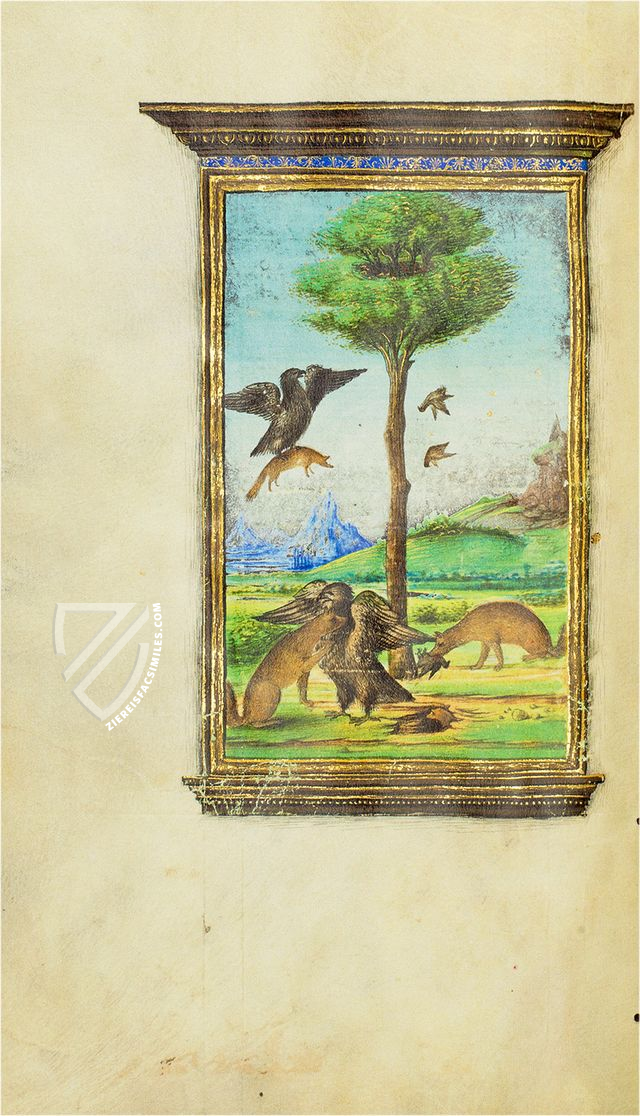
#1 Esopo Medici
Languages: Spanish, Italian, English, German
(3,000€ - 7,000€)
- Treatises / Secular Books
- Apocalypses / Beatus
- Astronomy / Astrology
- Bestiaries
- Bibles / Gospels
- Chronicles / History / Law
- Geography / Maps
- Saints' Lives
- Islam / Oriental
- Judaism / Hebrew
- Single Leaf Collections
- Leonardo da Vinci
- Literature / Poetry
- Liturgical Manuscripts
- Medicine / Botany / Alchemy
- Music
- Mythology / Prophecies
- Psalters
- Other Religious Books
- Games / Hunting
- Private Devotion Books
- Other Genres
- Afghanistan
- Armenia
- Austria
- Belgium
- Belize
- Bosnia and Herzegovina
- China
- Colombia
- Costa Rica
- Croatia
- Cyprus
- Czech Republic
- Denmark
- Egypt
- El Salvador
- Ethiopia
- France
- Germany
- Greece
- Guatemala
- Honduras
- Hungary
- India
- Iran
- Iraq
- Israel
- Italy
- Japan
- Jordan
- Kazakhstan
- Kyrgyzstan
- Lebanon
- Liechtenstein
- Luxembourg
- Mexico
- Morocco
- Netherlands
- Palestine
- Panama
- Peru
- Poland
- Portugal
- Romania
- Russia
- Serbia
- Spain
- Sri Lanka
- Sweden
- Switzerland
- Syria
- Tajikistan
- Turkey
- Turkmenistan
- Ukraine
- United Kingdom
- United States
- Uzbekistan
- Vatican City
- A. Oosthoek, van Holkema & Warendorf
- Aboca Museum
- Ajuntament de Valencia
- Akademie Verlag
- Akademische Druck- u. Verlagsanstalt (ADEVA)
- Aldo Ausilio Editore - Bottega d’Erasmo
- Alecto Historical Editions
- Alkuin Verlag
- Almqvist & Wiksell
- Amilcare Pizzi
- Andreas & Andreas Verlagsbuchhandlung
- Archa 90
- Archiv Verlag
- Archivi Edizioni
- Arnold Verlag
- ARS
- Ars Magna
- ArtCodex
- AyN Ediciones
- Azimuth Editions
- Badenia Verlag
- Bärenreiter-Verlag
- Belser Verlag
- Belser Verlag / WK Wertkontor
- Benziger Verlag
- Bernardinum Wydawnictwo
- BiblioGemma
- Biblioteca Apostolica Vaticana (Vaticanstadt, Vaticanstadt)
- Bibliotheca Palatina Faksimile Verlag
- Bibliotheca Rara
- Boydell & Brewer
- Bramante Edizioni
- Bredius Genootschap
- Brepols Publishers
- British Library
- C. Weckesser
- Caixa Catalunya
- Canesi
- CAPSA, Ars Scriptoria
- Caratzas Brothers, Publishers
- Carus Verlag
- Casamassima Libri
- Centrum Cartographie Verlag GmbH
- Chavane Verlag
- Christian Brandstätter Verlag
- Circulo Cientifico
- Club Bibliófilo Versol
- Club du Livre
- CM Editores
- Collegium Graphicum
- Collezione Apocrifa Da Vinci
- Comissão Nacional para as Comemorações dos Descobrimentos Portugueses
- Coron Verlag
- Corvina
- CTHS
- D. S. Brewer
- Damon
- De Agostini/UTET
- De Nederlandsche Boekhandel
- De Schutter
- Deuschle & Stemmle
- Deutscher Verlag für Kunstwissenschaft
- DIAMM
- Droz
- E. Schreiber Graphische Kunstanstalten
- Ediciones Boreal
- Ediciones Grial
- Ediclube
- Edições Inapa
- Edilan
- Editalia
- Edition Deuschle
- Edition Georg Popp
- Edition Leipzig
- Edition Libri Illustri
- Editiones Reales Sitios S. L.
- Éditions de l'Oiseau Lyre
- Editions Medicina Rara
- Editorial Casariego
- Editorial Mintzoa
- Editrice Antenore
- Editrice Velar
- Edizioni Edison
- Egeria, S.L.
- Eikon Editores
- Electa
- Emery Walker Limited
- Enciclopèdia Catalana
- Eos-Verlag
- Ephesus Publishing
- Ernst Battenberg
- Eugrammia Press
- Extraordinary Editions
- Fackelverlag
- Facsimila Art & Edition
- Facsimile Editions Ltd.
- Facsimilia Art & Edition Ebert KG
- Faksimile Verlag
- Feuermann Verlag
- Folger Shakespeare Library
- Franco Cosimo Panini Editore
- Friedrich Wittig Verlag
- Fundación Hullera Vasco-Leonesa
- G. Braziller
- Gabriele Mazzotta Editore
- Gebr. Mann Verlag
- Gesellschaft für graphische Industrie
- Getty Research Institute
- Giovanni Domenico de Rossi
- Giunti Editore
- Graffiti
- Grafica European Center of Fine Arts
- Guido Pressler
- Guillermo Blazquez
- Gustav Kiepenheuer
- H. N. Abrams
- Harrassowitz
- Harvard University Press
- Helikon
- Hendrickson Publishers
- Henning Oppermann
- Herder Verlag
- Hes & De Graaf Publishers
- Hoepli
- Holbein-Verlag
- Houghton Library
- Hugo Schmidt Verlag
- Idion Verlag
- Il Bulino, edizioni d'arte
- ILte
- Imago
- Insel Verlag
- Insel-Verlag Anton Kippenberger
- Instituto de Estudios Altoaragoneses
- Instituto Nacional de Antropología e Historia
- Introligatornia Budnik Jerzy
- Istituto dell'Enciclopedia Italiana - Treccani
- Istituto Ellenico di Studi Bizantini e Postbizantini
- Istituto Geografico De Agostini
- Istituto Poligrafico e Zecca dello Stato
- Italarte Art Establishments
- Jan Thorbecke Verlag
- Johnson Reprint Corporation
- Josef Stocker
- Josef Stocker-Schmid
- Jugoslavija
- Karl W. Hiersemann
- Kasper Straube
- Kaydeda Ediciones
- Kindler Verlag / Coron Verlag
- Kodansha International Ltd.
- Konrad Kölbl Verlag
- Kurt Wolff Verlag
- La Liberia dello Stato
- La Linea Editrice
- La Meta Editore
- Lambert Schneider
- Landeskreditbank Baden-Württemberg
- Leo S. Olschki
- Les Incunables
- Liber Artis
- Library of Congress
- Libreria Musicale Italiana
- Lichtdruck
- Lito Immagine Editore
- Lumen Artis
- Lund Humphries
- M. Moleiro Editor
- Maison des Sciences de l'homme et de la société de Poitiers
- Manuscriptum
- Martinus Nijhoff
- Maruzen-Yushodo Co. Ltd.
- MASA
- Massada Publishers
- McGraw-Hill
- Metropolitan Museum of Art
- Militos
- Millennium Liber
- Müller & Schindler
- Nahar - Stavit
- Nahar and Steimatzky
- National Library of Wales
- Neri Pozza
- Nova Charta
- Oceanum Verlag
- Odeon
- Orbis Mediaevalis
- Orbis Pictus
- Österreichische Staatsdruckerei
- Oxford University Press
- Pageant Books
- Parzellers Buchverlag
- Patrimonio Ediciones
- Pattloch Verlag
- PIAF
- Pieper Verlag
- Plon-Nourrit et cie
- Poligrafiche Bolis
- Presses Universitaires de Strasbourg
- Prestel Verlag
- Princeton University Press
- Prisma Verlag
- Priuli & Verlucca, editori
- Pro Sport Verlag
- Propyläen Verlag
- Pytheas Books
- Quaternio Verlag Luzern
- Reales Sitios
- Recht-Verlag
- Reichert Verlag
- Reichsdruckerei
- Reprint Verlag
- Riehn & Reusch
- Roberto Vattori Editore
- Rosenkilde and Bagger
- Roxburghe Club
- Salerno Editrice
- Saltellus Press
- Sandoz
- Sarajevo Svjetlost
- Schöck ArtPrint Kft.
- Schulsinger Brothers
- Scolar Press
- Scrinium
- Scripta Maneant
- Scriptorium
- Shazar
- Siloé, arte y bibliofilia
- SISMEL - Edizioni del Galluzzo
- Sociedad Mexicana de Antropología
- Société des Bibliophiles & Iconophiles de Belgique
- Soncin Publishing
- Sorli Ediciones
- Stainer and Bell
- Studer
- Styria Verlag
- Sumptibus Pragopress
- Szegedi Tudomànyegyetem
- Taberna Libraria
- Tarshish Books
- Taschen
- Tempus Libri
- Testimonio Compañía Editorial
- Thames and Hudson
- The Clear Vue Publishing Partnership Limited
- The Facsimile Codex
- The Folio Society
- The Marquess of Normanby
- The Richard III and Yorkist History Trust
- Tip.Le.Co
- TouchArt
- TREC Publishing House
- TRI Publishing Co.
- Trident Editore
- Tuliba Collection
- Typis Regiae Officinae Polygraphicae
- Union Verlag Berlin
- Universidad de Granada
- University of California Press
- University of Chicago Press
- Urs Graf
- Vallecchi
- Van Wijnen
- VCH, Acta Humaniora
- VDI Verlag
- VEB Deutscher Verlag für Musik
- Verlag Anton Pustet / Andreas Verlag
- Verlag Bibliophile Drucke Josef Stocker
- Verlag der Münchner Drucke
- Verlag für Regionalgeschichte
- Verlag Styria
- Vicent Garcia Editores
- W. Turnowski Ltd.
- W. Turnowsky
- Waanders Printers
- Wiener Mechitharisten-Congregation (Wien, Österreich)
- Wissenschaftliche Buchgesellschaft
- Wissenschaftliche Verlagsgesellschaft
- Wydawnictwo Dolnoslaskie
- Xuntanza Editorial
- Zakład Narodowy
- Zollikofer AG

